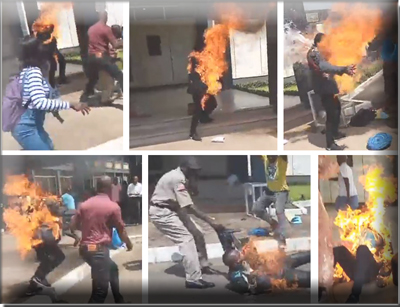Self-Immolation: A Proud Tradition of Protest
By: Theodore T. Hodge
The Perspective
Atlanta, Georgia
November 8, 2020
 |
|---|
| Comrade Archie Ponpon Set Himself Ablaze in a Protest |
As many gathered and watched in amazement, Comrade Archie Ponpon set himself ablaze on the grounds of the Temple of Justice in Monrovia, Liberia. Social media, in the form of FaceBook, went wild reporting the event, hardly doing any justice in analyzing the story behind the event. The conclusion was quickly reached that Mr. Ponpon had taken such a bold and audacious act because the Liberian government had failed to pay some of its employees, including Mr. Ponpon himself, for almost an entire year.
Mr. Ponpon’s attempt at self-immolation has clearly drawn sorrow and empathy from across the spectrum, but there are those who think he went too far… drawing the conclusion that his action was illogical and irrational. Why would a man set himself on fire simply because he did not get a paycheck; how would that better his condition? Based on that narrow viewpoint, he was sadly mocked by those unenlightened ones with hearts of stone. The question that comes to mind is: How could such a noble and courageous act be met with mockery? That is what saddens me as I weep for my country. My poor, dark, and backward country!
More dangerously, there are those, besides the cynical and sinister, who believe that the young man’s action may have been triggered by a mental health crisis. Crudely, some have remarked, “Maybe the man crazy.” But does it matter that there is absolutely no clinical evidence to support such a theory? Is setting oneself on fire something that mentally disturbed people are prone to do in our society?
To the contrary, we know from the reading of history, especially the history of social protests, brave and conscientious men and women have used self-immolation as a noble form of protest against injustice and oppression in their varied and diverse forms. One does not have to search too far to know that this practice has gone on since the third century to the present day, this form of protest has been used by conscientious objectors all over the world. Popular among Buddhist monks and nuns, it has been used in China, India, Tibet, Vietnam, and South Korea. Additionally, it has been used in the United States, Great Britain, France, Russia, Chile, Ukraine, and elsewhere.
The protestors of record, many of them martyred, have been men and women, ranging between the ages of twenty and eighty. They have been Buddhist, Catholic, Socialists, Communists, Capitalists and Atheists and other political, social, or religious actors committed to one cause or the other across a diverse spectrum. The one thing they have all had in common was to protest and draw attention to an issue for which they were willing to give their own lives; that is indeed a demonstration of the highest form of selflessness.
As has been clearly reiterated above, this form of protest is more common elsewhere than it is on the African continent. But two recent cases deserve mention: firstly, a street vendor named Mohamed Bouazizi set himself on fire on 17 December 2010. The incident became a catalyst for the Tunisian Revolution; it also sparked the flames that led to the “Arab Spring”, an uprising against autocratic regimes in the Arab World. According to Wikipedia, “His self-immolation was in response to the confiscation of his wares and the harassment and humiliation inflicted upon him by a municipal official and her aides.”
Secondly, In Algeria the following year, the headline read: “Algerian Dies From Self-Immolation… Man set himself on fire in protest over a lack of job and housing, in one of four attempted public suicides in a week…” Four attempted acts of self-immolation in one week!
Two points I have labored to drive home in this short essay. Firstly, what Comrade Archie Ponpon has done has a long tradition in various parts of the world. It is not uncommon for those who aim to draw attention to a major problem in society, be it political, philosophical, religious, economical, or social, to sacrifice their own lives in order to bring relief to others. Secondly, such an act could serve notice to those in leadership: Beware, there is trouble on the horizon.
Mr. Ponpon may have made himself the sacrificial lamb, which I believe is the greatest sacrifice to make. But undoubtedly, his message is clear and unmistaken: Beware of the canary in the coal mine; its presence denotes toxicity in the environment. Solution: Do not cover up; clean it up.
AUTOR’S NOTE: I do not believe Comrade Ponpon deserves to be mocked or his motive judged in jest. On the contrary, he deserves our empathy and honor. He has demonstrated high esteem in his selfless actions over the years. I propose we raise some funds through social media for his assistance. I have established a Go Fund Me account. Please show your support by giving me a feedback at imthodge@gmail.com or Theodore Tepane Hodge on Facebook.